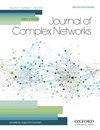Efficient eigenvalue counts for tree-like networks
IF 1.5
4区 数学
Q2 MATHEMATICS, INTERDISCIPLINARY APPLICATIONS
引用次数: 0
Abstract
Estimating the number of eigenvalues $\mu_{[a,b]}$ of a network’s adjacency matrix in a given interval $[a,b]$ is essential in several fields. The straightforward approach consists of calculating all the eigenvalues in $O(n^3)$ (where $n$ is the number of nodes in the network) and then counting the ones that belong to the interval $[a,b]$. Another approach is to use Sylvester’s law of inertia, which also requires $O(n^3)$. Although both methods provide the exact number of eigenvalues in $[a,b]$, their application for large networks is computationally infeasible. Sometimes, an approximation of $\mu_{[a,b]}$ is enough. In this case, Chebyshev’s method approximates $\mu_{[a,b]}$ in $O(|E|)$ (where $|E|$ is the number of edges). This study presents two alternatives to compute $\mu_{[a,b]}$ for locally tree-like networks: edge- and degree-based algorithms. The former presented a better accuracy than Chebyshev’s method. It runs in $O(d|E|)$, where $d$ is the number of iterations. The latter presented slightly lower accuracy but ran linearly ($O(n)$).树状网络的有效特征值计数
在给定区间$[a,b]$中估计网络邻接矩阵的特征值$\mu_{[a,b]}$的个数在几个领域是必不可少的。直接的方法包括计算$O(n^3)$(其中$n$是网络中的节点数)中的所有特征值,然后计算属于区间$[a,b]$的特征值。另一种方法是使用Sylvester惯性定律,它也需要$O(n^3)$。尽管这两种方法都提供了$[a,b]$中特征值的确切数量,但它们在大型网络中的应用在计算上是不可行的。有时,近似于$\mu_{[a,b]}$就足够了。在这种情况下,Chebyshev的方法在$O(|E|)$(其中$|E|$是边的数量)$ \mu_{[a,b]}$中逼近$\mu_{[a,b]}$。本研究提出了计算局部树状网络$\mu_{[a,b]}$的两种替代方法:基于边缘和基于度的算法。前者比切比雪夫的方法更精确。它在$O(d|E|)$中运行,其中$d$是迭代的次数。后者的准确率略低,但线性运行($O(n)$)。
本文章由计算机程序翻译,如有差异,请以英文原文为准。
求助全文
约1分钟内获得全文
求助全文
来源期刊

Journal of complex networks
MATHEMATICS, INTERDISCIPLINARY APPLICATIONS-
CiteScore
4.20
自引率
9.50%
发文量
40
期刊介绍:
Journal of Complex Networks publishes original articles and reviews with a significant contribution to the analysis and understanding of complex networks and its applications in diverse fields. Complex networks are loosely defined as networks with nontrivial topology and dynamics, which appear as the skeletons of complex systems in the real-world. The journal covers everything from the basic mathematical, physical and computational principles needed for studying complex networks to their applications leading to predictive models in molecular, biological, ecological, informational, engineering, social, technological and other systems. It includes, but is not limited to, the following topics: - Mathematical and numerical analysis of networks - Network theory and computer sciences - Structural analysis of networks - Dynamics on networks - Physical models on networks - Networks and epidemiology - Social, socio-economic and political networks - Ecological networks - Technological and infrastructural networks - Brain and tissue networks - Biological and molecular networks - Spatial networks - Techno-social networks i.e. online social networks, social networking sites, social media - Other applications of networks - Evolving networks - Multilayer networks - Game theory on networks - Biomedicine related networks - Animal social networks - Climate networks - Cognitive, language and informational network
 求助内容:
求助内容: 应助结果提醒方式:
应助结果提醒方式:


